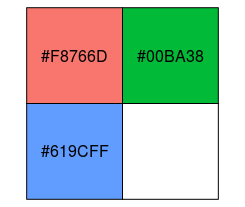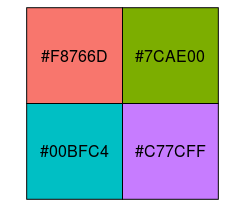ggplot2 default color palette
# demo("colors")
# showCols1()
# grDevices::colors()
# grDevices::demo("colors")
https://stackoverflow.com/questions/25211078/what-are-the-default-plotting-colors-in-r-or-ggplot2/25211125#25211125
https://stackoverflow.com/questions/8197559/emulate-ggplot2-default-color-palette
https://stackoverflow.com/questions/33221794/separate-palettes-for-facets-in-ggplot-facet-grid
ggplot 정보 확인
p <- ggplot(iris, aes(x=Sepal.Length, y=Petal.Length, color=Species)) + geom_point() p summary(p) ggplot_build(p)$data ggplot_build(p)$layout ggplot_build(p)$plot
ggplot 정보 중 ggplot_build(p)$data
ggplot_build(p)$data # colour x y PANEL group shape size fill alpha stroke #1 #F8766D 5.1 1.4 1 1 19 1.5 NA NA 0.5 #... #51 #00BA38 7.0 4.7 1 2 19 1.5 NA NA 0.5 #... #101 #619CFF 6.3 6.0 1 3 19 1.5 NA NA 0.5 #...
<참고> emulate ggplot2's default color palette
Hadley Wickham 의 ggplot1책 106 페이지
"The default colour scheme, scale_colour_hue picks evenly spaced hues around the hcl colour wheel"
library(scales) show_col(hue_pal()(3)) show_col(hue_pal()(4)) #[1] "#F8766D" "#00BA38" "#619CFF" #[1] "#F8766D" "#7CAE00" "#00BFC4" "#C77CFF"


Color 설정하여 그리기
library(scales) p <- ggplot(iris, aes(x=Sepal.Length, y=Petal.Length, color=Species)) iris2 <- cbind(iris, ggcolor=ggplot_build(p)$data[[1]][, 1]) p <- ggplot(iris2, aes(x=Sepal.Length, y=Petal.Length, color=ggcolor)) + geom_point()
color유지하면서 plot => groupOfColor
p <- ggplot(iris, aes(x=Sepal.Length, y=Petal.Length, color=Species))
groupOfColor <- ggplot_build(p)$data[[1]][, 1] %>% unique
names(groupOfColor) <- iris2$Species %>% unique
# groupOfColor
p <- ggplot(iris2, aes(x=Sepal.Length, y=Petal.Length, color=Species)) +
geom_point() +
scale_color_manual(values=groupOfColor)
Manual color
data <- data.table( x=runif(10), y=runif(10), grp=factor(rep(LETTERS[1:5], each=2)))
myColors <- c("#f48025","#edd16f","#8ab96b","#4fb496","#2e74a5","#1c3d9d","#553693","#913db0",
"#e776b9","#f78d9f","#e54d4c","#ffba57","#c2e389","#7fdfd4","#459bd8","#727ee9",
"#b99fed","#ff99d6","#ae74e5","#8698ee","#77c7db","#559b51","#a2d252","#f0fbaf",
"#fbdfaf","#dd5e60","#a98160","#926038" )
data %>% ggplot(aes(x=x, color=grp)) + geom_point(aes(y=y)) +
scale_colour_manual(values=myColors)
factor별
library(RColorBrewer) brewer.pal.info display.brewer.all(type="div") display.brewer.all(type="seq") display.brewer.all(type="qual") display.brewer.all(10, exact.n=T)
myColors <- brewer.pal(length(levels(data$grp)), "Set1") names(myColors) <- levels(data$grp) myColScale <- scale_colour_manual(name="grp", values=myColors) p1 <- data %>% ggplot(aes(x,y,color=grp)) + geom_point() + myColScale p2_1 <- data[4:10,] %>% ggplot(aes(x,y,color=grp)) + geom_point() + myColScale p2_2 <- p1 %+% droplevels(subset(data[4:10,]))